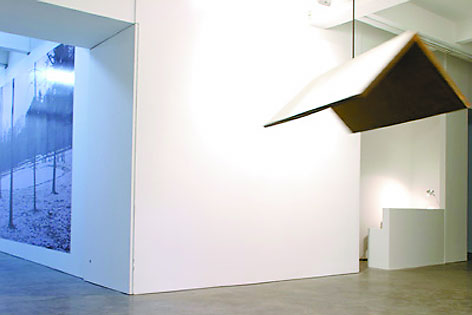Paul Chan’s solo debut show mixes diverse media; Balka explores confinement
Miroslaw Balka’s “190 x 122 x 64,” a foam rubber and steel roof, at the entrance to the artist’s “Neither” exhibition, evokes a tornado-borne home from the “The Wizard of Oz.”
The notion of home is experienced in widely different ways, from associating it with a physical place of upbringing to memorializing a place of patriotic or nationalistic sentiment. Troops hear public pleas for their return home, homemaker extraordinaire Martha Stewart is doing time, and “lifestyles,” emphasized first and foremost as a domestic affair, has become a key marketing phenomenon. Culture’s focus on home, now more than ever, reflects a grounded instinct, an attempt to create stability in what are increasingly unstable times.
Miroslaw Balka’s exhibition “Neither” at Barbara Gladstone Gallery is pervaded with a sense of domestic unease. On entering the gallery, one walks under “190 x 122 x 64” (2004), a rotating peaked roof, hanging from the ceiling, made of steel and foam rubber. It recalls Dorothy’s home spinning out of control in that Kansas twister, though decidedly more austere and elegiac in its slow turning.
“Winterreise (Bambi, Bambi, Pond)” (2003) is a series of three separate video projections, drained of color, each coupled with a rotating, floor-bound table top containing a single white porcelain dinner plate. All of the images were shot in the Brzezinka Concentration Camp at Birkenau, under a blanket of snow. One shows a pond, and the other two feature deer seemingly trapped behind barbed wire. Set in front of each of the projections, a place is set for a lonely diner, with no room for another guest. One imagines the diner focusing only inward, alone, constantly circling herself. Balka’s dark humor feels affected, yet his perversity offers release.
Paul Chan’s show at Greene Naftali, “My birds…trash…the future,” envisions the construction of the domestic as inseparable from social and political entanglements. A large two-sided video projection screen hangs from the ceiling, filled to its frame with two separate flash-animation scenarios. Sacrificed prisoners hang from Goya-style trees, striking uncomfortable comparisons to recently circulated images, like those from Abu Ghraib.
Meanwhile maimed tourists in iconic yellow Hummers stop to take pictures, and birds swoop down from black smoke-filled skies. A soundtrack of downloaded ringtones bolsters the crudeness of Chan’s animation. With a mixture of sincere and ironic cultural references, Chan balances an urgent message with an opportunity for slower personal reflection, creating a work that is a call to consider our comforts, and a call-to-action.



































